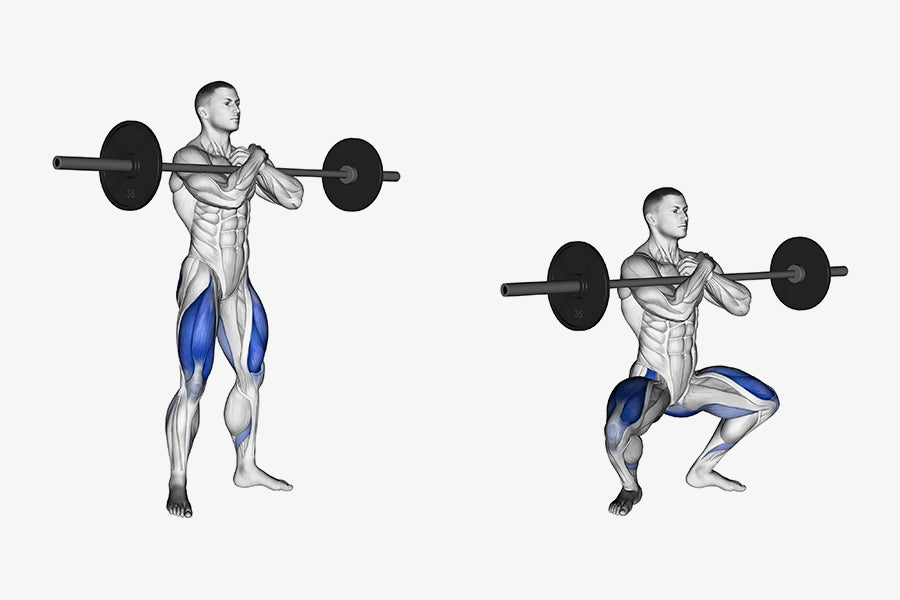The Zercher Squat is an effective and challenging exercise that works various muscles, including the glutes, hips, and legs. Developed by weightlifting pioneer Ed Zercher in the 1930s, this squat variation has become popular among athletes and strength trainers thanks to its many benefits.
This article will discuss how to perform the Zercher Squat correctly, its variations, muscles worked, and tips to get started.
How to Do the Zercher Squat & Which Muscles are Worked?

To begin the Zercher Squat, you will need a barbell.
- Begin by standing with your feet slightly wider than hip-width apart, toes pointing outward.
- Place the barbell or weighted implement in the crook of your elbows.
- The weight will rest on your forearms and upper arms below your biceps.
- Then bend your knees and hips to lower yourself into a squat position.
- Make sure you keep your chest up, back straight, and core engaged as you move down into the squat.
- Once you have reached the bottom of the movement, press through your mid foot to stand up again.
- From here, proceed to perform the same movement as above.
The Zercher Squat is an excellent exercise for building strength in several muscles. It mainly targets the glutes and quads but also works the hamstrings, hips, core, and upper back. The muscles in your arms must also work hard to support the weight during each rep.
Quadriceps
If you're looking to maximize the tension and strain applied to your quadriceps, look no further than the Zercher squat! This specific type of squat requires that you achieve a deep, vertical position—thus creating greater knee flexion. This enables a better stretch for your quads than other squats, such as hip dominant or slightly less upright ones; it also increases loading.
Glutes
The glutes are heavily engaged during the squat, especially when you press deeper and lower with each repetition. These muscles act as a stabilizer in the deep portion of the squat to ensure that your form is correct and help provide strength for standing up with power and intent.
Abdominals and Obliques
When weight is shifted away from the midline, your muscles must strain to bear down on it. Front-loading in movements makes them even more exhausting and stimulates the abs and obliques, as you need much better anterior core stability to perform Zercher squats correctly. The increased intensity will push your body further than before!
Lats and Upper Back
Performing the Zercher squat requires you to stand as uprightly as possible by placing and holding the load in front of your body. Your upper back and lat muscles maintain a straight torso while securing the weight around your elbows.
This posture helps improve core strength and can help build overall stability throughout your body.
Biceps
Engaging your biceps is essential when lifting any type of load. The Zercher squat requires the biceps to be in a constant state of contraction, creating more stability during the movement and allowing you to lift heavier weights easily.
Benefits of Zercher Squats
The Zercher Squats is an excellent exercise for working out various muscle groups and provide the following benefits:
Increased Leg, Glute & Core Strength
Zercher squats allow you to lift heavier weights, which increases the level of strength developed in your legs and glutes. In addition, they require a great deal of core engagement, further strengthening the muscles of your abdomen.
Improved Posture & Flexibility
The Zercher Squat forces you to keep your chest up while maintaining an upright posture during the exercise, improving your overall posture in everyday life.
Furthermore, the Zercher Squat requires a more fantastic range of motion than traditional squats, resulting in improved hip and ankle flexibility. This increased flexibility can help prevent injuries while also improving overall mobility.
Decreases Risk of Injury
By shifting the weight away from the spine and into the arms/shoulders, Zercher squats take some strain off your lower back, reducing any potential for injury caused by lifting heavy weights with poor form.
Challenges Stabilizing Muscles
Because it requires more excellent balance and coordination than traditional squats, Zercher squats force you to recruit additional stabilizing muscles—such as the adductors, hamstrings, and glutes—which can help strengthen your entire body.
By altering how you hold and lift the weight, Zercher squats are more challenging than traditional back squats or front squats, making them an excellent tool for pushing yourself to new limits.
Improved Range of Motion
Due to the unique position of the barbell during Zercher squats, you’ll be able to deepen your squat and expand your range of motion, allowing for a better workout. If you’re looking for a change of pace from your regular squat routine, Zercher Squats can provide a fresh challenge while working for similar muscle groups.
Greater Muscle Activation
As the weight is positioned lower on the body when performing Zercher Squats, more muscles have to be activated throughout the entire exercise, making them especially beneficial for building strength and muscle size.
Speeds Up Fat Burning & Improves Balance
As Zercher squats require more balance than regular squats, they are ideal for improving your overall balance and coordination, specifically for physical activities involving agility.
Additionally, Zercher squats can help you improve your metabolism, speeding up the fat-burning process and resulting in a better physique over time.
Increased Bone Density
In addition to building strong muscles, the weight-bearing nature of Zercher Squats helps increase bone density, which is essential for preventing injuries and issues associated with less bone mass.
Related Article: Workout Plan to Build Stronger Core & Strength
Zercher Squat Variations
These variations of the Zercher Squat provide an opportunity to target different muscle groups while still building strength in the same area as the original version. Give them a try and see what works best for you!
Off-Set Zercher Squat

In this variation, you will use a landmine attachment and place one side of the barbell in the crooks of your elbows. You will also have to use a split squat stance instead of a squat stance. This offsets the weight and creates an imbalance that will work different muscles to maintain stability.
How to Do It?
- Begin by standing in split squat position. Your forward leg will be the one closest to the barbell.
- Hook both elbows around the sleeve of the barbell.
- Descend into the split squat to your max depth and explode out of the bottom to the original position.
- Repeat on both sides for an even workout.
Front Squat

The front squat moves the weight to the front of your body, which changes the angle and how muscles are used.
How to Do It?
- Begin by holding the barbell across your chest with your elbows up.
- then lower into a squatting position before pushing back up to standing.
Related Article: Front Squat Vs. Back Squat: Which is Better for Building Muscle
Goblet Squat

This variation uses one or two dumbbells instead of a barbell and is excellent for building strength in your legs and core.
How to Do It?
- Start by holding one dumbbell at chest height and then lower yourself into a squatting position.
- Push back up to standing and repeat.
- Make sure to keep your core engaged throughout the entire movement.
Box Squat

This variation uses a bench or box as a guide and helps with form while still getting in a full-body workout.
How to Do It?
- Start by setting the bench behind you.
- Lower yourself into position while holding a barbell or dumbbell, then push back up to standing.
The Right Way to Incorporate Zercher Squats Into Your Routine
When doing any strength training, it’s essential to focus on form. The Zercher Squat is no exception. It’s recommended that you begin with light weight and gradually increase as your form improves.
Start by adding 10-15% of your body weight onto the barbell and use this for practice reps until you are comfortable with the movement. Once ready, add more weight in small increments—5 to 10 pounds at a time—until you reach a challenging but doable weight for 3-4 sets of 8-12 reps.
It’s best to take a few days between sessions so your muscles can recover and adjust to the new weight before increasing again. With practice, you’ll be able to find your ideal weight for the Zercher Squat and get stronger with each workout!
Follow the Zercher squat tips mentioned below to get started:
Start Light: As with any exercise, starting with a weight you can handle is essential. This will ensure you can perform each rep with good form.
Engage Your Core: Your core should be tight throughout each rep to provide stability for the spine and lower back.
Keep Your Chest Up: Make sure your chest remains high throughout each rep to help keep the weight balanced.
Brace Your Arms: Your arms should be tight and support the weight throughout each rep.
Concentrate on the Hip Drive: As you stand back up from the bottom of the squat, drive your hips forward to complete the movement.
The Bottom Line
Overall, Zercher squats are an incredibly beneficial exercise that can help improve your posture, strength, balance, and coordination and provide numerous other health benefits. This is the exercise for you if you’re looking for a challenging way to mix up your workout routine.
So if you’re ready to take on the challenge of Zercher Squats, it’s essential to ensure you have the correct form and technique before attempting any heavy weights. This unique variation on traditional squats can significantly add to your fitness regimen with practice and patience. Happy squatting!











